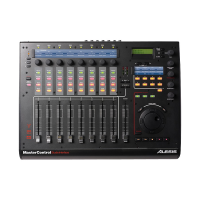section 7: the arpeggiator and the sequencer
getting the most out of this in the andromeda.
7.1 sequencer tutorial 101:
From Arnd:
The A6 sequencer is an analog-style step sequencer. It does not record like a realtime sequencer
would. Instead it uses manually entered values for up to three rows of sixteen steps of control
voltages. The default assignment for these rows is note value, velocity and gate time. Alternatively,
any moddestination can be used as well, using the mod buttons in every module. You can also
change the length of a sequence or insert a rest at any point.
In order to facilitate the data entry of note values, you may use the keyboard to enter not data. Just
turn the USEKBD parameter on (soft knob 8 on the CONFIG page).
(USEKBD note: The sequencer can not be turned on when entering in parameters. This can
trick many a person, so just keep this in mind. – Chad)
Sequences are stored within a program. When a program is stored with the sequencer on, playback
will start when you press a key. There are many other trigger options but this should be the most
common. You may also save a program with a sequence but the sequencer stopped. Now you can
play as usual but at any point you can start the sequence manually using the START/STOP button.
An important element of the step sequencer and arpeggiator sections is the SYNC/MOD page. You
have three options for triggering/synchronizing a sequence or arpeggiator pattern. (Press the SYNC/
MOD button in the sequencer or arpeggiator section. Then press soft button 5 to go to the SYNC
page.
LOCAL: with this setting, the sequence is free running, with the tempo set within the program. In a
MIX, multiple sequences would be playing with their individual tempo. No synchronization between
the sequences.
CLOCK: the sequence tempo is determined by the master clock tempo (system wide). In a MIX,
multiple sequences will play in sync.
MIDI: the sequence tempo is determined by an incoming MIDI clock. In a MIX, multiple sequences
will play in sync to an incoming MIDI clock. Make sure your external sequencer is set to transmit
MIDI clock (some do not by default). You will only hear the sequences play when the external clock
is present, e.g. when the external sequencer is running.
In order to make handling the different clock options easier, the A6 presets on preset bank 1 are set
sync to master clock. You can now set the master clock to MIDI and all preset programs
incorporating a sequence will sync to MIDI clock.
You need to keep in mind that this is a different concept than other sequencers, specially computer
based. YES, you can have multiple sequenced bass or lead lines play in sync (or you can use the
sequencer to build drum sequences). Then, all you need to do is make sure that the note-on events
are all on the same beat.
BUT: this is only where the fun starts. I take the sequencer as a part of the sound (intentionally per
voice, not per program) and I program simple rhythmic patterns on the same note number, so when
you play notes at different beats, you create interesting rhythmic patterns. The clock makes sure
that everything is in sync (means: the beats are aligned), but it doesn't tell you where the sequence
has to start.
Try Preset1/014 "Beryllium Sphere" as an example. This is one of my programs where I tried to use
the sequencer in such way. Play a chord. You get a simple rhythmic pattern. But when you play the
same chord arpeggiated (play the notes one after the other in 1/16th or 1/8th), the individual

